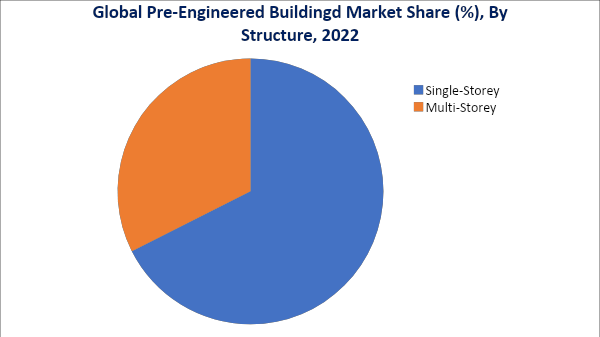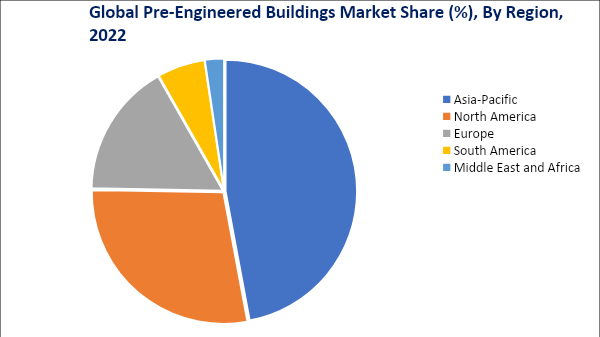Pre-Engineered Buildings Market Size
The Global Pre-Engineered Buildings Market size reached USD 14.6 billion in 2022 and is expected to reach USD 37.9 billion by 2030 growing with a CAGR of 12.6% during the forecast period 2024-2031.
The global pre-engineered buildings market has experienced significant growth in recent years due to the increasing demand for quick and efficient construction solutions, rapid industrialization, urbanization and the need for flexible building designs to accommodate various industries.
Various regions across the globe are promoting the adoption of PEBs due to their associated advantages over traditional construction methods. These advantages include reduced construction time, cost-effectiveness, design flexibility, durability, energy efficiency and ease of customization.
Emerging economies, particularly in Asia-Pacific and the Middle East, have witnessed significant demand for PEBs due to their rapid urbanization, industrial expansion and infrastructure projects. Asia-Pacific is expected to hold more than 60.3% in the forecast period in the global pre-engineered buildings market and countries like India and China are expected to cover 2/3rd of the region.
Market Scope
| Metrics | Details |
| CAGR | 12.6% |
| Size Available for Years | 2022-2031 |
| Forecast Period | 2024-2031 |
| Data Availability | Value (USD ) |
| Segments Covered | Structure, Application and Region |
| Regions Covered | North America, Europe, Asia-Pacific, South America and Middle East & Africa |
| Fastest Growing Region | Asia-Pacific |
| Largest Region | Asia-Pacific |
| Report Insights Covered | Competitive Landscape Analysis, Company Profile Analysis, Market Size, Share, Growth, Demand, Recent Developments, Mergers and Acquisitions, New Equipment Type Launches, Growth Strategies, Revenue Analysis, Porter’s Analysis, Pricing Analysis, Regulatory Analysis, Supply-Chain Analysis and Other key Insights. |
To know more insights Download Sample
Pre-Engineered Buildings Market Dynamics
Increasing Infrastructure Investments In Fast-Growing Economies
Increasing infrastructure investments owing to the rise in industrialization and urbanization in developing economies such as India, Vietnam and China are expected to drive the pre-engineered buildings market.
India plans to spend USD 1.4 trillion on infrastructure during 2019-23 to have sustainable development of the country. Investments are happening in sectors like retail, urban development, industrial, aviation and hospitality.
Besides, rising investments in commercial spaces are expected to positively contribute to the pre-engineered building market revenue. For instance, in 2022 IIG release the information of 269 investment projects in the Commercial Real Estate subsector in India worth USD 1.62 billion. Furthermore, for the first time in 2022, China's annual commercial real estate investment is projected to exceed USD 47 billion (300 billion yuan).
Last year, China's commercial real estate investment experienced an impressive rebound as the total amount of transactions increased 33% year over year to 273 billion yuan. Due to the robust market, the amount for the following year is anticipated to increase by between 10 and 15% and exceed 300 billion yuan.
Sustainability and Green Building Practices
Increasing awareness of environmental issues and the need for sustainable development has led to a shift towards green building practices. Pre-engineered buildings offer several advantages in terms of sustainability, including energy efficiency, reduced carbon footprint and minimized waste generation.
The use of environmental-friendly materials, energy-efficient designs and renewable energy integration in pre-engineered buildings aligns with the goals of sustainable construction.
Various projects are running on the sustainable prefabricated concept. For instance Baoye Center project, Baoye Group’s headquarters building in Shanghai. It's important to note that 40% of the Baoye Centre project consists of prefabricated building materials.
The project serves as an example of "maximizing the quality of office space" and incorporates green practices in the areas of air tightness, water tightness, energy efficiency and building materials. By LEED v2009: Core and Shell, Shanghai Baoye Centre gained LEED Gold certification in 2018.
Competition From Traditional Construction Practices
The construction industry is known for its resistance to change and adherence to traditional construction practices. Some stakeholders may be hesitant to adopt pre-engineered buildings due to unfamiliarity with the technology, concerns about quality and durability or resistance to deviating from conventional construction methods. Overcoming this resistance requires education, awareness campaigns and showcasing successful pre-engineered building projects.
Furthermore, despite the advantages and cost-effectiveness of pre-engineered buildings, there may be a lack of awareness and understanding among potential customers, including developers, architects and contractors. The market's growth may be hindered if potential buyers are not familiar with the benefits and capabilities of pre-engineered buildings compared to traditional construction methods.
Pre-Engineered Buildings Market Segment Analysis
The global pre-engineered buildings market is segmented based on structure, application and region.
Rising Demand For Flexible Designs in Single-Storey Buildings
Single-Storey holds a share of around 52.1% of the global pre-engineered buildings market. Single-storey pre-engineered buildings (PEBs) are prefabricated or pre-manufactured structures using standardized designs and parts. These buildings are typically used for industrial, commercial, or agricultural purposes and are designed and fabricated in a factory before being transported to the construction site for assembly.
Pre-engineered buildings are well-suited for single-story applications due to their versatility and adaptability. Single-story structures can be easily designed and constructed using pre-engineered building systems to meet specific requirements, whether it's for warehouses, industrial facilities, retail outlets, recreational spaces, or institutional buildings. The flexibility in design allows for customization and optimization of the building layout, size and functional requirements, making pre-engineered buildings an attractive option for single-story projects.

Pre-Engineered Buildings Market Geographical Share
Asia-Pacific’s Cheap Labor, Trade Liberalization and Favorable Government Construction Policies
Asia-Pacific accounted for the largest market share of more than 48.8% in the year 2022 and is also projected to record the highest growth rate during the forecast period. The growth in the Asia-Pacific can be attributed to the increasing demand for pre-engineered buildings from the growing non-residential construction and infrastructural development in the region.
The major demand for pre-engineered buildings in the region is contributed by India and China, owing to the growing population, economic growth, government investments and demand for low-cost green buildings.
Furthermore, foreign investors are setting up their factories and distribution centers in the developing countries of Asia-Pacific owing to cheap labor, trade liberalization and favorable government policies, further boosting the pre-engineered buildings market growth. It acts as an opportunity for the pre-engineered building manufacturers and suppliers in this region.

Pre-Engineered Buildings Companies
The major global players include Tata BlueScope Steel, Era Infra, Everest Industries, Interarch Building Products, Jindal Prefab, Kirby Building Systems, Lloyd Insulations, PEB Steel Buildings, Tiger Steel Engineering and Zamil Steel.
COVID Impact
The pandemic shifted priorities in the construction industry, with a greater focus on health, safety and sustainability. While pre-engineered buildings offer advantages in terms of sustainability and faster construction, the immediate concerns related to pandemic safety measures overshadowed other considerations, impacting the market's growth potential.
Furthermore, the need for remote working and social distancing measures presented challenges for project management, coordination and collaboration. The adoption of remote working practices slowed down decision-making processes, communication and project implementation, affecting the overall construction industry, including the pre-engineered buildings market.
Russia-Ukraine War Impact
The conflict has primarily affected the region of Eastern Europe, including Ukraine and neighboring countries. The geopolitical instability and security concerns have disrupted construction activities and supply chains in the affected areas. The disruption impacted the demand for pre-engineered buildings and slow down market growth in the region.
The conflict and its aftermath have led to the delay or cancellation of construction projects in the affected regions. Uncertainty surrounding the security situation, economic instability and shifting priorities can result in postponed or abandoned projects. As a result, the demand for pre-engineered buildings in those areas is negatively impacted.
Key Developments
- On 23 March 2022, PEB Steel Buildings Co., Ltd. (Pebsteel), a growing pre-engineering steel construction company, launches its refreshed brand identity to the market. The branding complements Pebsteel's long-term goal of providing clients with cutting-edge, economical solutions during a new development stage.
- On 22 February 2022, World leader in construction technology Trimble announced that Zamil Steel, a Middle Eastern leader in pre-engineered steel buildings and structural steel products, has selected its software, such as Tekla PowerFab, to revolutionize steel fabrication in its factories in Saudi Arabia, India, Egypt and Vietnam. Zamil Steel is a global leader in engineering and manufacturing a variety of high-quality steel products.
- On 05 February 2023, To meet the rising demand for pre-engineered buildings in the southern States, Greater Noida, India -based EPACK Prefab Private Limited is investing roughly 200 crores in the construction of a new PEB manufacturing facility in the Tirupati district. According to a press statement from the company's director, this facility would increase the company's existing production capacity of 1,00,000 metric tonnes per year (MTPA) by 84,000 MTPA.
Why Purchase the Report?
- To visualize the global pre-engineered buildings market segmentation based on structure, application and region, as well as understand key commercial assets and players.
- Identify commercial opportunities by analyzing trends and co-development.
- Excel data sheet with numerous data points of pre-engineered buildings market level with all segments.
- PDF report consists of a comprehensive analysis after exhaustive qualitative interviews and an in-depth study.
- Product mapping available as Excel consisting of key products of all the major players.
The Global Pre-engineered Buildings Market Report Would Provide Approximately 53 Tables, 45 Figures and 211 Pages.
Target Audience 2024
- Manufacturers / Buyers
- Industry Investors/Investment Bankers
- Research Professionals
- Emerging Companies